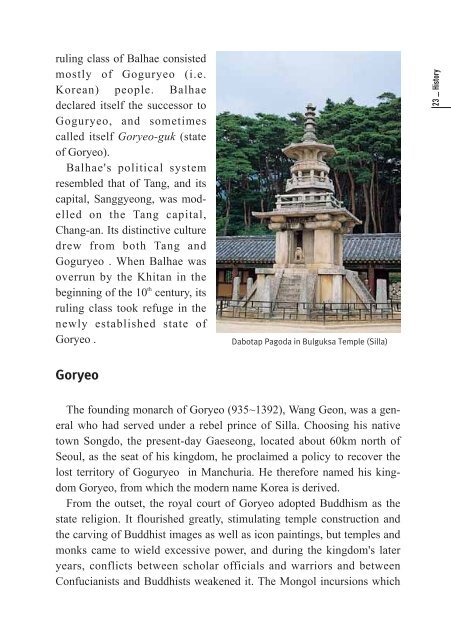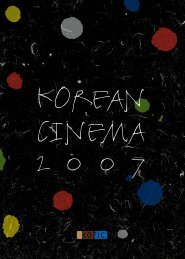HELLO from KOREA
Hello-Eng(3.3) - Korea.net
Hello-Eng(3.3) - Korea.net
- No tags were found...
Create successful ePaper yourself
Turn your PDF publications into a flip-book with our unique Google optimized e-Paper software.
uling class of Balhae consisted<br />
mostly of Goguryeo (i.e.<br />
Korean) people. Balhae<br />
declared itself the successor to<br />
Goguryeo, and sometimes<br />
called itself Goryeo-guk (state<br />
of Goryeo).<br />
Balhae's political system<br />
resembled that of Tang, and its<br />
capital, Sanggyeong, was modelled<br />
on the Tang capital,<br />
Chang-an. Its distinctive culture<br />
drew <strong>from</strong> both Tang and<br />
Goguryeo . When Balhae was<br />
overrun by the Khitan in the<br />
beginning of the 10 th century, its<br />
ruling class took refuge in the<br />
newly established state of<br />
Goryeo .<br />
Dabotap Pagoda in Bulguksa Temple (Silla)<br />
23 _ History<br />
Goryeo<br />
The founding monarch of Goryeo (935~1392), Wang Geon, was a general<br />
who had served under a rebel prince of Silla. Choosing his native<br />
town Songdo, the present-day Gaeseong, located about 60km north of<br />
Seoul, as the seat of his kingdom, he proclaimed a policy to recover the<br />
lost territory of Goguryeo in Manchuria. He therefore named his kingdom<br />
Goryeo, <strong>from</strong> which the modern name Korea is derived.<br />
From the outset, the royal court of Goryeo adopted Buddhism as the<br />
state religion. It flourished greatly, stimulating temple construction and<br />
the carving of Buddhist images as well as icon paintings, but temples and<br />
monks came to wield excessive power, and during the kingdom's later<br />
years, conflicts between scholar officials and warriors and between<br />
Confucianists and Buddhists weakened it. The Mongol incursions which
















